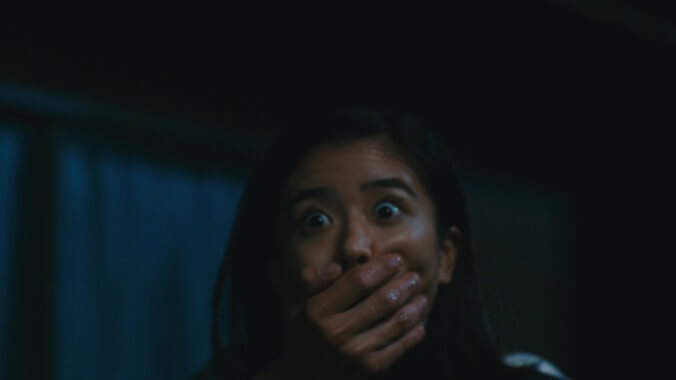Most prequels to popular horror franchises can be charitably described as “unnecessary,” and changing the format from feature film to six-part TV series doesn’t help Ju-On: Origins avoid the same fate. Worse yet for fans of the source material (whether the original Ju-On or its English remakes under The Grudge titles), it’s not even a proper prequel. Instead, it opens with text informing the viewer that the movies may have been fiction, but they were “inspired” by these “real events” we’re about to see. In other words, goodbye Kayako and Toshio, the deadly woman and child ghosts from the series, and hello, Kiyomi and Toshiki, their nigh-interchangeable replacements. There are some tweaks to the basic mythology underlying the franchise, and while the show (Netflix’s first Japanese original series) requires no knowledge of its cinematic predecessors, those familiar with it will see some of that series’ more glaring weaknesses (inexplicable rules to the curse, nonsensical motivations for numerous characters) on full display here.
Beginning in 1988, the series follows Haruka (Yuina Kuroshima), an actor who records the unexplainable footsteps she’s been hearing at night and shares it with Yasuo Odajima (Yoshiyoshi Arakawa), a man researching paranormal encounters for a book he’s writing. Meanwhile, Kiyomi Kawai (Ririka) is a student who has just transferred schools, and takes up an offer from a couple of girls at her new institution to explore an abandoned house that stray cats are known to frequent. Without giving anything away, the house is quickly revealed to pass on disturbing visions to those who enter it, and both Haruka and Kiyomi end up having traumatic, though very different, experiences influenced by the mysterious place (Haruka’s boyfriend went to see it while shopping for a home for the two of them), and the resulting events set them on very different paths in life. Beginning with episode three, we pick up six years later, with Haruka and Odajima both still unable to move past the seemingly haunted domicile and the strange curse that befalls those who enter it. Kiyomi, by contrast, has tried to forget her experience (she goes by Kumi now), but her tempestuous relationship and young son, Toshiki, lead her inexorably into the orbit of not only Haruka and Odajima, but a host of new characters affected by the ongoing mystery.
A straightforward recounting of events would quickly get tangled—not to mention spoiler-heavy—because another thing Origins shares with its big-screen predecessors is a preference for time-shifting narratives, as experiences of the past overlap with those in the present and future when it comes to goings-on within the supernatural residence. Eventual reveals of just what happened to each character are tied to prior and future events, in ways that sometimes make sense, and sometimes just devolve into the narrative equivalent of “Hey, it’s supernatural—anything goes, right?”
As a delivery system for scares, Ju-On: Origins is only fitfully successful. While nearly every episode has at least one sequence that induces edge-of-seat creepiness (the penultimate episode, which shows the true scope of Odajima’s backstory, is the best of these), more often than not the horrifying events aren’t so much scary as simply brutal, disturbing, or just downright ugly. The first episode, viewers should be warned, contains a nasty (and narratively unjustified) sexual assault not in the least bit supernatural, and there are scenes of violence that range from eerie to over-the-top gruesome. The blood and viscera is mostly practical, giving gore f/x aficionados some nice tableaux to pore over—one scene involving a pregnant woman is as horrifying as anything in a splatter film—and the ghost visuals contain admirably restrained use of CGI. Origins sometimes summons scares and laughter in equal measure, such as when a character in jail gets visited by a baby that makes the ceiling-crawling infant from Trainspotting look downright adorable.
If only there were compelling characters anchoring all this ghostly hokum. Most of the actors do fine work with what little they’re given on the page (Kuroshima, in particular, manages to convey depths of emotion with almost nothing save for her expressive face), but when they’re offered such one-dimensional roles, there’s only so much emoting that can help. And for the characters who are granted rich backstories, like Kiyomi, the show tends to use “troubled” as an excuse to push and pull their motivations and moods any which way, consistency be damned. The narrative doesn’t help by containing little in the way of a beginning, middle, or end; by relying so heavily on the convoluted timeline and the blurring of one era into another, the story feels less like it has an arc, and more a series of events that just sort of happen. When the actual ending does come after six episodes, it feels like a shrug, as though once they got done explaining what happened to these people in the past, they realized there wasn’t anything to say in the present. (One character is killed so absurdly in the final minutes, it suggests the creative team was just trying to get to the finish line.)
In some regards, this messy but sporadically engaging series makes for the ideal embodiment of a film series that similarly struggled to remain compelling after the initial scares subsided. Like its spotty progenitors, Ju-On: Origins tries to stretch thin material over a large canvas without doing much to sustain interest beyond injecting the occasional fright. (To its credit, there are almost no cheap jump scares here.) Horror fans are unfortunately well acquainted with sitting through limp characters and narrative filler to get to the good stuff; this haunted-house series will supply sufficient ghouls to keep your attention—but it also conjures up the spirit of shows that have done it better.


